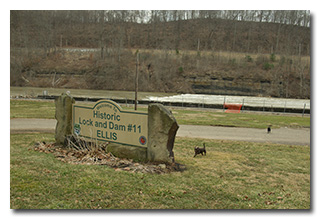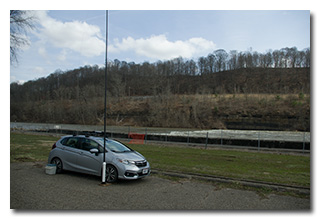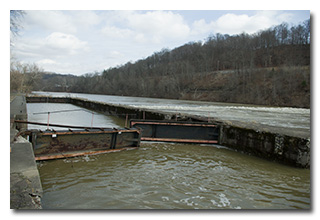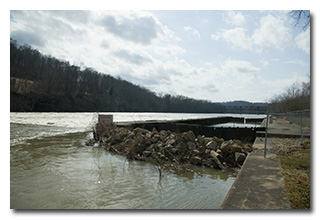
by William Eric McFadden
From the park's website:
-
The Muskingum River Parkway State Park has been placed on the National Register of Historic Places and is recognized as the Muskingum River Navigation Historic District. In its day, the system of locks and dams helped open the state and the entire Midwest to trade and development. It is the only remaining system of hand-operated locks in the nation.
The locks help boats safely bypass ten dams on the Muskingum River from Zanesville south to the Ohio River at Marietta. These locks are operated at no charge for recreational boats. Ten of the eleven locks still function— the northernmost lock, Ellis #11, is no longer in operation but offers a campground. The remaining locks have a variety of amenities and many communities along the Muskingum River offer recreational and sight-seeing opportunities for boaters and non-boaters alike. Visitors may enjoy watching the river from the park's picnic shelter south of Lock #7 on State Route 376.
From the Muskingum River Water Trail map and brochure:
-
(Ellis Lock and Dam #11) Enjoy the remoteness and scenery of this area, which includes Powelson Wildlife Area. A partially constructed bike trail parallels the river. A short distance downstream you pass under a bikeway located on an abandoned railroad trestle. Zanesville Yacht Club, about 6.3 miles downstream, offers gas to boaters when open.
Pictures
Description
 On Sunday, March 6, 2022, one member of the Southeast Ohio Radio Adventure Team
performed a successful activation of Muskingum River State Park in Ohio as part of the Parks on the
Air (POTA; link) program.
On Sunday, March 6, 2022, one member of the Southeast Ohio Radio Adventure Team
performed a successful activation of Muskingum River State Park in Ohio as part of the Parks on the
Air (POTA; link) program.
Having decided that his goal within POTA for the next few months would be to earn the Oasis Repeat Offender Activator Award for Muskingum River State Park by visiting all ten of the river-navigation locks and dams that make up the state park, Eric McFadden, WD8RIF, escaped a rainy southeastern Ohio and visited the Ellis Lock and Dam #11 on a rain-free but blustery day, arriving at the lock at about 1815 UTC. Eric was accompanied by his wife Vickie, KC8MAJ, and the little dogs Mindy and Theo.
This was to be Eric's tenth activation of Muskingum River State Park, with his previous activations having occurred at...
- Devola Lock #2 (2022-02-18),
- Lowell Lock #3 (2022-02-25),
- Luke Chute Lock #5 (2022-02-19),
- Stockport Lock #6 (2018-09-15 / 2021-05-29),
- McConnelsville Lock #7 (2022-02-21),
- Rokeby Lock #8 (2021-02-27),
- Philo Lock #9 (2022-03-04), and
- Zanesville Lock #10 (2021-07-23).
 Finding the lock parking lot to be empty, Eric parked his car and, while little dogs Mindy and Theo frolicked, he deployed
his 28½' wire vertical on a Jackite 31' telescoping fiberglass mast and drive-on mount and, because of the blustery
wind, set up his KX3 inside the car. Eric was on the air at 1830 UTC.
Finding the lock parking lot to be empty, Eric parked his car and, while little dogs Mindy and Theo frolicked, he deployed
his 28½' wire vertical on a Jackite 31' telescoping fiberglass mast and drive-on mount and, because of the blustery
wind, set up his KX3 inside the car. Eric was on the air at 1830 UTC.
Because he had been unsure he would find cell-signal at this location, Eric had previously announced his activation on POTA Spots (link) with hopes that POTA Spots would automatically spot him based on Reverse Beacon Network (RBN, link) spots, and he had asked his friends K4SWL and K8RAT to watch RBN for him. Somewhat to his surprise, Eric found that he did have good cell-signal at this location, and he was able spot himself to POTA Spots and to use POTA Spots to identify possible park-to-park (P2P) QSO opportunities.
Eric began operations on 40m by finding a frequency to run and beginning to call "CQ POTA". Eric was pleased that POTA Spots did automatically spot him. Eric's first QSO came at 1831 UTC with NT2A in New York. QSOs came so quickly Eric had no hope of finishing his lunchtime sandwich, with his twenty-fifth QSO coming at 1854 UTC with NT4W in Kentucky. This run included QSOs with operators located in New York (4), Pennsylvania (5), Tennessee, North Carolina (3) , Illinois (3), Ohio (3), Quebec, Georgia, Ontario, New Jersey, Michigan, and Kentucky.
Eric finished his activation by checking POTA Spots for P2P QSO opportunities and at 1901 UTC he made a P2P QSO on 20m with WD5GRW who was activating Hagerman National Wildlife Refuge (K-0548) in Texas. (And only then was Eric able to finish his sandwich.)
In all, Eric made twenty-six QSOs, including one P2P QSO. All of Eric's QSOs were CW and were made with five watts output.
Eric also submitted his log to the World Wide Flora and Fauna in Amateur Radio (WWFF; link) program.
(return)

